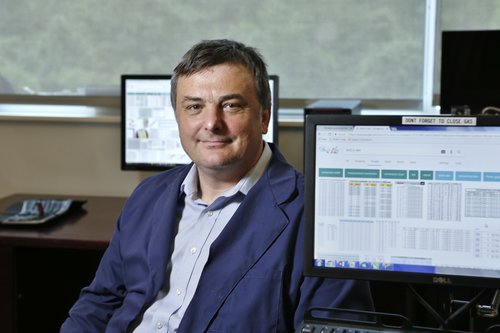Cold facts: To absolute zero, and beyond, with Next Cryo

Slowa Solovyov will give you something to cryo about.
The physicist who came in from the cold – master’s in applied physics from Moscow’s Institute for Physics and Technology, PhD in solid-state physics from Ukraine’s Institute for Metal Physics, 23-year U.S. Department of Energy materials scientist – is diving into the coldest environments man can create, on a quest to improve quantum-level efficiencies.
Dr. Solovyov, who has also served for six years as an adjunct Stony Brook University professor of electrical engineering, has bundled up before. In 2015, along with Brookhaven Technology Group President Paul Farrell, he launched NextSwitch, an ambitious startup focused on high-temperature superconductivity.
“High-temperature superconductivity” is a bit of a misnomer. In this case, “high” refers to temperatures above 77 degrees Kelvin, or roughly minus 321 degrees Fahrenheit – frosty on your skin but the boiling point of liquid nitrogen, a primary coolant in the world of cryogenics.
With his new startup, Mr. Freeze is looking to really chill out. Scheduled to debut in January, Next Cryo will focus on reducing losses in quantum computing through the composition of new materials and the application of some truly frigid temps.
Large quantum computers require extremely cold environments; the typical MRI machine operates around absolute zero (about minus 460 Fahrenheit), but your run-of-the-mill quantum computer operates at temperatures “about 50 times lower,” according to Dr. Solovyov.
Turning down the temperature, the scientist notes, is actually about turning down the volume.
“When you operate in the quantum world, you want to reduce noise,” he says. “And temperature is what makes noise. Temperature destroys connections between quanta, or information.”
Enter Next Cryo, which will look to commercialize new material technologies that reduce those losses and, essentially, enable quantum computers to do their thing. And the possibilities don’t end in the quantum realm: The cutting-edge materials promise similar benefits for numerous sciences where cold is hot, including “superconducting magnets, fusion reactors and other cutting-edge tech,” according to Dr. Solovyov.
First up for the startup is development of a signal-management system for large quantum computers. Like any computer chip, quantum-computing chips are connected by power and signal lines, but the “fundamental laws of nature,” Dr. Solovyov says, make maintaining them difficult at best – and the mere presence of those connecting wires in the temperature-controlled quantum environment debilitates computing efficiencies.
“When you run all the wires from room temperature, the room we live in, to the quantum world were the computations are going on, the heat can travel through those wires,” Dr. Solovyov notes. “Heat travels from hot to cold. So, you are essentially introducing a heat load … to the ultra-low cryogenic environment.”
The ultimate goal is a system that’s powerful enough to promote new efficiencies and small enough to be practical – and “the same with delivering currents to a superconducting magnet” and other applications where transferring power or data via conventional metal wires just won’t do.
The basic plan is simple: materials preparation and testing at the Advanced Energy Research and Technology Center (AERTC), validation at Brookhaven National Laboratory and customer pilots engaging “major quantum-computing companies,” according to Dr. Solovyov, with on-point customer feedback eventually leading to a breakthrough product.
“There are a lot of different solutions and approaches,” Dr. Solovyov notes. “But what the product should actually look like is the goal of this customer-discovery process.”
Next Cryo should have “a good idea of what the product will look like” in about a year, adds the entrepreneur, who’s launching the spinoff on his own but says both NextSwitch and the 2021 startup would be lost in quantum space without the tools and professional connections provided by the AERTC.
Right at the top: major contributions by Dr. Chung-Chueh “Simon” Chang, project director and instrumentation scientist for the AERTC’s Thermomechanical & Imaging Nanoscale Characterization facility.
“Simon was a great asset in helping us evaluate the structures of different materials,” Dr. Solovyov says. “Plus, there are many other tools in the energy center – there are the analytic tools and the electron microscope, which is critical to the development process.
“The AERTC always has great resources.”
